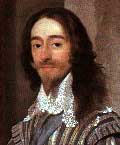| Second son of James VI of Scotland (James I in England) and Anne of Denmark; became heir apparent on the death of his older brother, Henry Frederick (6/16 Nov 1612); succeeded to his father's throne in 1625; in first years of his reign, he remained under the influence of George Villiers, 1st Duke of Buckingham; took a hostile attitude towards the Parliament, refusing to grant funds for the war with Spain and disapproving of the king's religious policies; convoked and dissolved three Parliaments in 1625-1629; ordered the adjournment of Parliament (1629) and had several parliamentary leaders imprisoned; governed without a Parliament (1629-1640) using forced loans and other extraordinary financial measures to meet governmental expenses; attempted to impose the Anglican liturgy upon Scotland that led to the Bishops' Wars (1639, 1640); summoned the Parliament in 1640 to raise an army and funds; abruptly dissolved it on 5/15 May 1640 ("Short Parliament") in response to demands of discussion of various abuses of power; summoned his fifth Parliament ("Long Parliament"), which turned against the chief royal advisers, William Laud and the Earl of Strafford, who were imprisoned and executed; assented to the Triennial Act (1641), mandating the summoning of Parliament every three years; received the Grand Remonstrance (22 Nov/2 Dec 1641), which was passed by the House of Commons and enlisted reform demands; ordered the arrest of six members of Parliament and entered the House of Commons with an armed force (4/14 Jan 1642), violating parliamentary privileges; abandoned London (10/20 Jan 1642), setting up his court at Oxford; raised an army, starting the Civil War (1642), which lasted until 1646 when the royalist troops were disbanded and Charles surrendered to the Scottish army (5/15 May 1646); having refused to accept Presbyterianism in Scotland, he was handed over as a prisoner to parliamentary commissioners in Newcastle (23 Jan/2 Feb 1647); was kidnapped by the New Model Army (4/14 Jun 1647) which turned hostile to the Parliament; escaped (11/21 Nov 1647) to the Isle of Wight, where he was kept under surveillance in Carisbrooke Castle; managed to negotiate with a Scottish group the secret "Engagement" (26 Dec 1647/5 Jan 1648), promising to establish Presbyterianism in England, triggering off the second phase of the Civil Wars, a series of Royalist rebellions, and a Scottish invasion (1648); after the defeat of the Scots at the Battle of Preston (1648), he was moved to Hurst Castle in Hampshire and thereafter to Windsor Castle; was tried by the court appointed by Parliament and sentenced to death as "a Tyrant, Traitor, Murderer, and a public Enemy"; beheaded in London. |

